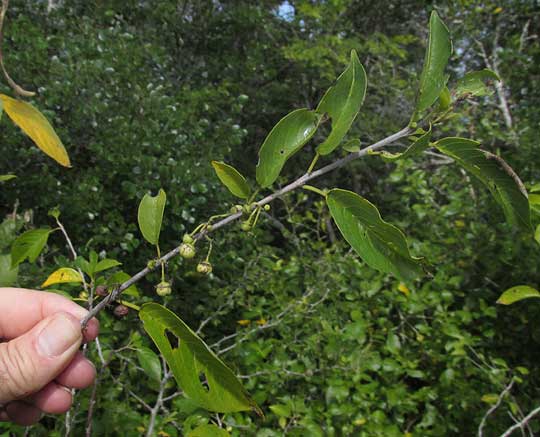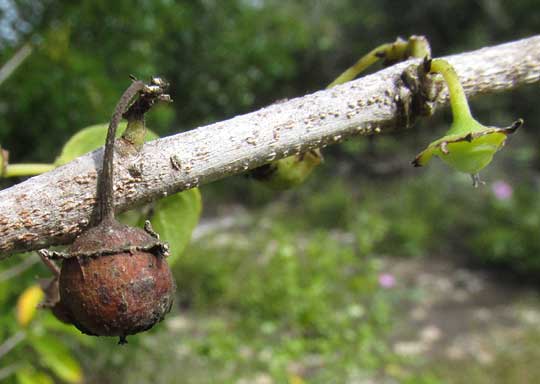Excerpts from Jim Conrad's
Naturalist Newsletter
from the January 25, 2015 Newsletter issued from Río Lagartos, on the Yucatan Peninsula's northern coast (~N21.60°, ~W88.16°), Yucatán state, MÉXICO
SNAKEWOOD
Sometimes the most interesting stories are those told by nondescript individuals usually overlooked in the tangle of things. That's how it was with a certain head-tall bush or small tree found the other day so intricately enmeshed in a thicket of other small trees and bushes that taking a picture of it would have shown nothing but a hodgepodge of stems. However, the plain-looking little thing was fruiting and I figured I ought to look. The mosquitoes where horrific so for such a plain-Jane tree, even if it was fruiting, I didn't try too hard to get good pictures. Just snap a couple of shots while swatting at mosquitoes and get out of there. Below, you can see a stiff, slender twig bearing ordinary, bug-eaten leaves and those fruits:

A twig with a mature fruit and a flower a little past it prime, with the petals fallen off and the ovary beginning to swell, both arising from a gray, hairless stem warty with tiny lenticels is shown below:

Even through the mosquitoes I could see that the pea-sized fruits were unusual in that their bases appeared to be cupped with the remains of the former flower's calyx. They looked like fruits we've looked at before, on a small tree called Snakebark, Colubrina arborescens, seen down at Chichén Itzá in the central Yucatan. You can compare Snakebark's fruits with those on our mosquito tree at www.backyardnature.net/yucatan/colubrina.htm.
The similarities are so striking that our mosquito tree has to be another Colubrina species. Three Colubrina species are listed for the Ría Lagartos Biosphere Reserve, so is our modest little tangle tree one of those? Doing image searches on the Internet for each species, it was easy to determine that our modest bush is COLUBRINA ELLIPTICA, known by a host of English names, including Snakewood, Soldierwood, Nakedwood, Greenheart, Hogplum and Mauby. Snakewood is a member of the Buckthorn Family, the Rhamnaceae, and is distributed from the Florida Keys throughout the Caribbean, Mexico and Central America, south to northern South America. Colubrina elliptica can be distinguished from the Yucatan's other two Colubrina species by its hairless leaves and stems.
One thing making Snakewood interesting is that in the Caribbean a fermented drink with a taste like root beer with herbal bitters added is made from its bark. The drink is called Mauby and normally it's brewed from Snakewood bark, spices and brown sugar. After a froth forms and is skimmed off, yeast from a previous batch is added, and this is allowed to ferment a day or two. Wikipedia's Mauby Page is at https://en.wikipedia.org/wiki/Mauby.
Medicinally the drink is regarded as a tonic and sometimes is used against diarrhea, dysentery and hypertension. A 2005 study by Marroquín-Segura and others found that a Snakewood extract significantly reduced blood glucose levels in rats, so maybe there's something to its fame as a medicinal drink.